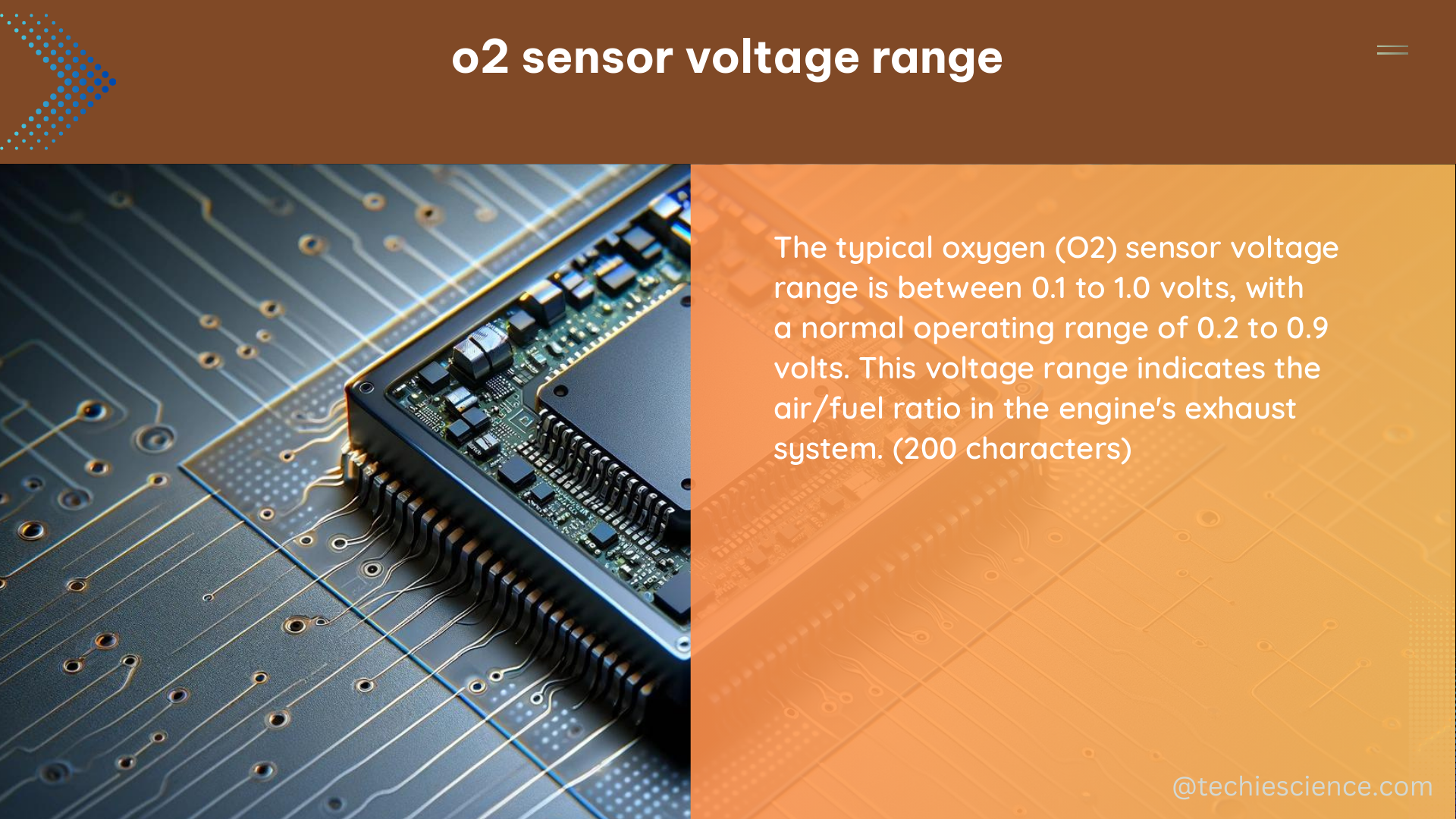The oxygen (O2) sensor, also known as the lambda sensor, is a critical component in the engine management system of modern vehicles. It plays a vital role in monitoring the air-fuel ratio and providing feedback to the engine control unit (ECU) to maintain optimal combustion efficiency and reduce emissions. Understanding the O2 sensor voltage range is essential for proper diagnosis and troubleshooting of engine performance issues.
Understanding O2 Sensor Voltage Fluctuations
The voltage output of an O2 sensor typically ranges between 0.1 volts and 1.0 volts, with rapid fluctuations as the sensor measures the oxygen content in the exhaust gas. This voltage range can vary slightly depending on the specific make and model of the vehicle.
When the air-fuel mixture is lean (too much air, not enough fuel), the O2 sensor will output a lower voltage, typically around 0.1 volts. Conversely, when the mixture is rich (too much fuel, not enough air), the sensor will output a higher voltage, closer to 1.0 volts.
The ECU uses this voltage information to adjust the fuel injection and ignition timing to maintain the optimal air-fuel ratio for efficient and clean combustion. The ideal air-fuel ratio for most gasoline engines is around 14.7:1, known as the stoichiometric ratio.
Factors Affecting O2 Sensor Voltage

Several factors can influence the O2 sensor voltage range and its fluctuations, including:
-
Engine Load and Throttle Position: During wide-open throttle (WOT) conditions, the ECU may allow the fuel mixture to run slightly rich, resulting in a higher O2 sensor voltage, typically around 800 millivolts (0.8 volts) with an air-fuel ratio of approximately 12.5 to 13.9.
-
Engine Temperature: The O2 sensor’s voltage output can be affected by the engine’s operating temperature. When the engine is cold, the sensor may not reach its optimal operating temperature, leading to a delayed or erratic voltage response.
-
Sensor Aging and Deterioration: Over time, the O2 sensor can become contaminated or deteriorate, affecting its voltage output and response time. This can result in a narrower voltage range or a delayed voltage response.
-
Exhaust System Leaks: Leaks in the exhaust system can introduce additional air, causing the air-fuel mixture to become leaner and the O2 sensor to output a lower voltage.
-
Fuel Injector Issues: Problems with the fuel injectors, such as clogging or malfunctioning, can lead to an imbalance in the air-fuel ratio, affecting the O2 sensor’s voltage output.
Measuring O2 Sensor Voltage
Accurately measuring the O2 sensor voltage can be challenging due to the rapid fluctuations in the signal. Using a standard multimeter is not the best approach, as these instruments are too slow to capture the dynamic changes in voltage.
For a more accurate assessment of the O2 sensor’s voltage range and response, it is recommended to use a digital storage oscilloscope (DSO) or a wideband O2 sensor setup. These tools can provide a detailed view of the sensor’s voltage signal, allowing you to analyze the voltage range, response time, and any irregularities.
When using a DSO, you should observe the following:
- Voltage range: Typically between 0.1 volts and 1.0 volts, with rapid fluctuations.
- Response time: The sensor should respond quickly to changes in the air-fuel ratio, with a transition time of less than 100 milliseconds.
- Voltage waveform: The waveform should be smooth and consistent, without any significant irregularities or spikes.
Diagnosing O2 Sensor Issues
If you suspect an issue with the O2 sensor, you can perform the following diagnostic steps:
- Visual Inspection: Check the sensor for signs of damage, such as cracks, corrosion, or loose connections.
- Voltage Range Test: Use a DSO or wideband O2 sensor setup to verify that the sensor’s voltage output falls within the expected range of 0.1 volts to 1.0 volts and that the voltage fluctuates as expected.
- Response Time Test: Observe the sensor’s response time to changes in the air-fuel ratio, ensuring it transitions within the recommended 100 milliseconds.
- Sensor Replacement: If the O2 sensor is not functioning within the expected parameters, replace it with a new, genuine part.
Conclusion
The O2 sensor voltage range is a critical parameter in the engine management system, providing the ECU with the necessary feedback to maintain optimal air-fuel ratio and combustion efficiency. Understanding the typical voltage range, factors affecting it, and the proper methods for measuring and diagnosing O2 sensor issues can help you effectively troubleshoot and maintain your vehicle’s performance.
References:
- JustAnswer: Need education on how to read and interpret live O2 sensor voltage
- Reddit: Oxygen Sensor Normal Voltage Range
- Honda-Tech: O2 Sensor Voltage Range & F Reading
- Focus Fanatics: O2 Sensor Voltage Range
- F150Forum: O2 Sensor Voltage Question

The lambdageeks.com Core SME Team is a group of experienced subject matter experts from diverse scientific and technical fields including Physics, Chemistry, Technology,Electronics & Electrical Engineering, Automotive, Mechanical Engineering. Our team collaborates to create high-quality, well-researched articles on a wide range of science and technology topics for the lambdageeks.com website.
All Our Senior SME are having more than 7 Years of experience in the respective fields . They are either Working Industry Professionals or assocaited With different Universities. Refer Our Authors Page to get to know About our Core SMEs.